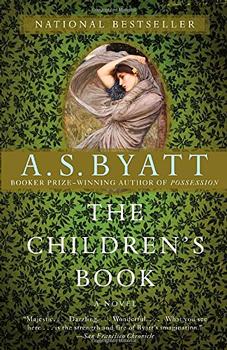Summary | Excerpt | Reading Guide | Reviews | Beyond the Book | Read-Alikes | Genres & Themes | Author Bio

A Novel
by A.S. ByattThis article relates to The Children's Book
One of the main characters in The Children's Book is Phillip Warren, apprentice to eccentric master of ceramics Benedict Fludd. While Fludd is a fictional creation, the kind of pottery being made in his house is in a style that came to be known, in the early 20th century, as Studio Pottery - that is to say pottery made by artists working alone or in small groups, producing unique items or small quantities of similar items.
In the wake of the industrialization of pottery in the previous centuries, those who created unique items from earthen- and stone-ware struggled to have their work accepted as art. Some of the leaders of the Studio Pottery tradition were William Staite Murray, Bernard Leach and Michael Cardew. Were Phillip Warren a real person, he would have been making his pots at the same time as Murray, the earliest of the studio potters.
 William Staite Murray was born in London in 1881, and had his own pottery there in the 1920s. He patented a gas-fired kiln design that made it easier to heat his work consistently. By 1925 he was teaching at the Royal College of Art, where he influenced the next generation of studio potters.
William Staite Murray was born in London in 1881, and had his own pottery there in the 1920s. He patented a gas-fired kiln design that made it easier to heat his work consistently. By 1925 he was teaching at the Royal College of Art, where he influenced the next generation of studio potters.
 Bernard Leach was born in Hong Kong to English parents, learned pottery in Japan and was successful there before moving to England in 1920. Leach was a central figure in the craft community in England for more than 50 years.
Bernard Leach was born in Hong Kong to English parents, learned pottery in Japan and was successful there before moving to England in 1920. Leach was a central figure in the craft community in England for more than 50 years.
 Michael Cardew was born in 1901. He gained a scholarship to read Classics at Oxford but was already focused on pottery and thus graduated with a third class degree. He was apprenticed to Leach, and was a student of Staite Murray's. He spent much of his middle years in Africa building and managing potteries.
Michael Cardew was born in 1901. He gained a scholarship to read Classics at Oxford but was already focused on pottery and thus graduated with a third class degree. He was apprenticed to Leach, and was a student of Staite Murray's. He spent much of his middle years in Africa building and managing potteries.
Filed under Music and the Arts
![]() This "beyond the book article" relates to The Children's Book. It originally ran in October 2009 and has been updated for the
August 2010 paperback edition.
Go to magazine.
This "beyond the book article" relates to The Children's Book. It originally ran in October 2009 and has been updated for the
August 2010 paperback edition.
Go to magazine.




The truth does not change according to our ability to stomach it
Click Here to find out who said this, as well as discovering other famous literary quotes!
Your guide toexceptional books
BookBrowse seeks out and recommends the best in contemporary fiction and nonfiction—books that not only engage and entertain but also deepen our understanding of ourselves and the world around us.